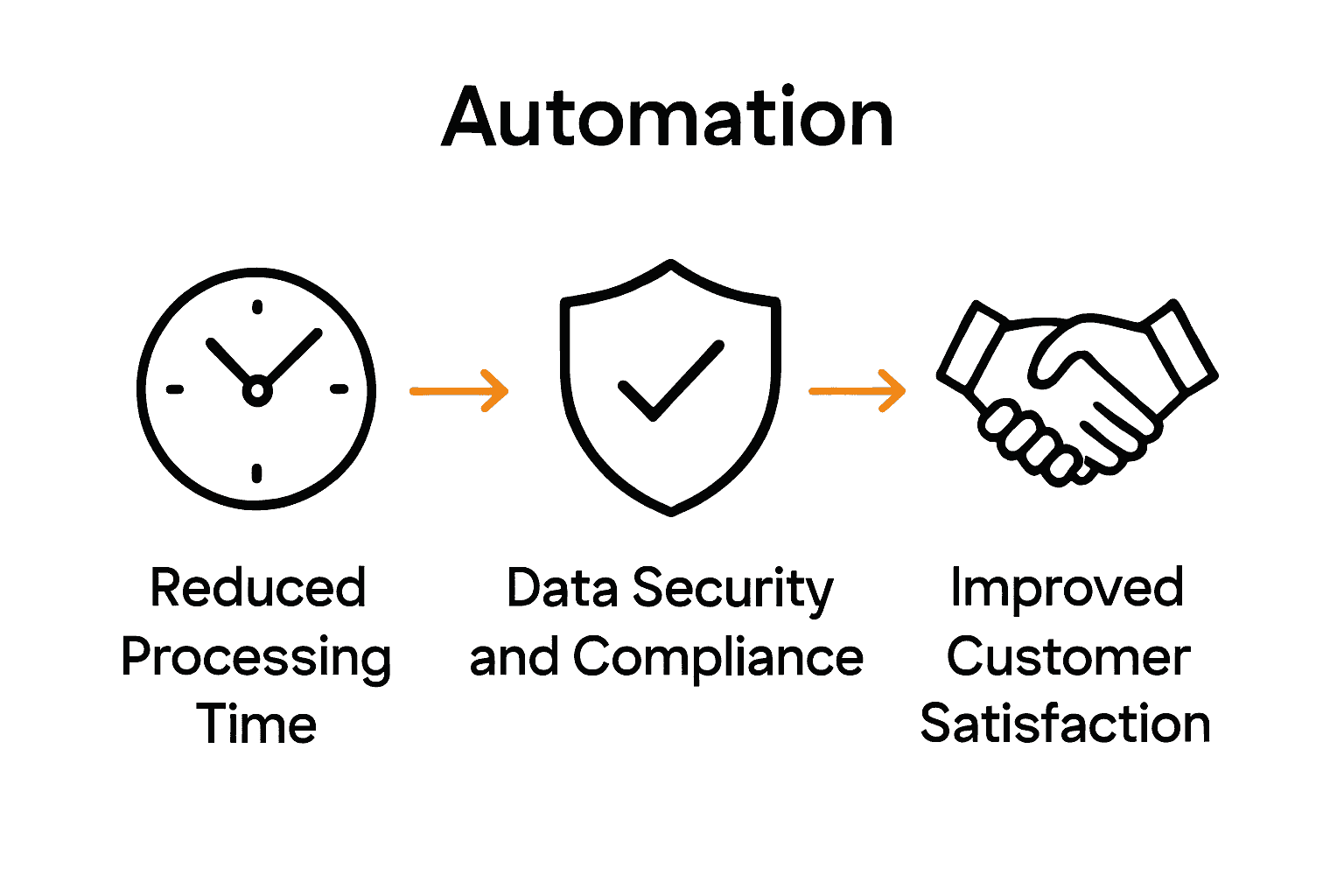Why Insurers Need Automation: Complete Guide
12.11.25

Manual insurance processes can drain resources and slow down operations, but automation has been shown to reduce processing times from days to minutes. In a world where efficiency means staying competitive, insurers are turning to digital solutions that speed up claims, improve accuracy, and deliver a better customer experience. This article explains what insurance automation is, reveals its expanding reach across the industry, and highlights how it is transforming the future for both companies and policyholders.
Table of Contents
- Defining Insurance Automation And Its Scope
- Types Of Automation In P&C Insurance
- Core Benefits For Insurers And Customers
- Regulatory And Compliance Requirements
- Risks, Costs, And Implementation Challenges
Key Takeaways
| Point | Details |
|---|---|
| Insurance Automation Enhances Efficiency | Automation streamlines operational processes, significantly reducing processing times and improving accuracy across claims, underwriting, and customer service. |
| Transformative Benefits for Stakeholders | Advanced automation leads to cost reductions and enhances customer experience through faster, more transparent interactions. |
| Regulatory Compliance Through Automation | Automation aids in navigating complex regulatory landscapes, ensuring transparent decision-making and maintaining data privacy. |
| Implementation Challenges Exist | Insurers face challenges such as integration with legacy systems, initial investment costs, and workforce adaptation that must be addressed for successful automation. |
Defining Insurance Automation And Its Scope
Insurance automation represents a strategic digital transformation approach that leverages technology to streamline complex operational processes within the insurance ecosystem. At its core, automation transforms manual, time-consuming tasks into efficient, technology-driven workflows that reduce human intervention and minimize potential errors.
According to research from arxiv.org, insurance automation can dramatically improve operational scalability. The study highlighted a compelling case where a large language model (LLM) was deployed to automate claim part identification – a task previously performed manually and recognized as a significant bottleneck for organizational growth. This exemplifies how intelligent automation can revolutionize traditionally labor-intensive insurance processes.

The scope of insurance automation extends across multiple critical domains:
- Claims Processing: Automated claim assessment and settlement
- Underwriting: Risk evaluation using advanced algorithmic techniques
- Customer Service: AI-powered chatbots and intelligent response systems
- Compliance Management: Automated regulatory monitoring and reporting
- Data Analytics: Real-time insights generation and predictive modeling
Interestingly, arxiv.org research also indicates growing interest in explainable artificial intelligence (XAI) techniques within the insurance sector. This suggests that modern automation isn’t just about efficiency, but also about creating transparent, trustworthy technological solutions that stakeholders can understand and validate.
By embracing automation, insurers can transform their operational paradigms – reducing processing times, enhancing accuracy, improving customer experiences, and ultimately driving competitive advantage in an increasingly digital marketplace.
Types Of Automation In P&C Insurance
Property and Casualty (P&C) insurers are increasingly adopting automation technologies across multiple operational domains, transforming traditional insurance workflows with intelligent digital solutions. These technological interventions range from simple rule-based systems to advanced artificial intelligence applications that can dramatically reshape insurance processes.
According to research from OECD, insurers are implementing different automation tools particularly for high-volume, low-value retail lines of business. This strategic approach enables organizations to optimize resource allocation and improve operational efficiency.
The primary types of automation in P&C insurance include:
- Underwriting Automation: Leveraging algorithms to assess risk, determine pricing, and make rapid policy decisions
- Claims Processing Automation: Streamlining claim intake, assessment, and settlement processes
- Customer Service Automation: Implementing chatbots and intelligent response systems
- Regulatory Compliance Automation: Monitoring and reporting regulatory requirements automatically
- Data Analytics Automation: Generating predictive insights and real-time risk assessments
Research from Finantrix highlights that intelligent automation can automatically process and classify claims immediately upon reporting, significantly reducing processing time and enhancing overall operational efficiency. Automation and Artificial Intelligence in P&C Insurance provides deeper insights into how these technological interventions are reshaping the insurance landscape.
By strategically implementing these automation types, P&C insurers can achieve substantial improvements in speed, accuracy, customer satisfaction, and competitive positioning.
The future of insurance lies not just in adopting technology, but in intelligently integrating it to create more responsive, efficient, and customer-centric operational models.
Core Benefits For Insurers And Customers
Automation in insurance delivers transformative benefits that fundamentally reshape how insurers operate and interact with customers. By leveraging advanced technologies, insurance organizations can create a more streamlined, efficient, and responsive ecosystem that serves both business objectives and customer expectations.
Research from IAEME demonstrates that automation of underwriting enables insurers to process applications significantly faster while maintaining rigorous standards of risk assessment. This efficiency translates into tangible advantages for both insurers and policyholders.
Key benefits of insurance automation include:
- Accelerated Processing Times: Reducing application and claims processing from days to minutes
- Enhanced Accuracy: Minimizing human error through algorithmic evaluations
- Cost Reduction: Lowering operational expenses by automating repetitive tasks
- Improved Customer Experience: Providing faster, more transparent service interactions
- Advanced Risk Management: Utilizing sophisticated predictive analytics for better decision-making
According to The London Economic, automated software helps insurance agents save hours of work, allowing them to focus on more value-added activities. This shift enables professionals to concentrate on complex problem-solving, customer relationship management, and strategic planning.
 Understanding Digital Insurance Platform Benefits offers deeper insights into how technological transformation can revolutionize insurance operations.
Understanding Digital Insurance Platform Benefits offers deeper insights into how technological transformation can revolutionize insurance operations.
Ultimately, automation represents more than a technological upgrade—it’s a strategic approach to creating a more responsive, intelligent, and customer-centric insurance ecosystem that can adapt quickly to evolving market demands and customer expectations.
Regulatory And Compliance Requirements
In the complex landscape of insurance, regulatory compliance represents a critical challenge that demands sophisticated technological solutions. Automation emerges as a powerful mechanism for insurers to navigate increasingly intricate regulatory environments while maintaining transparency, accuracy, and risk management.
Research from arXiv investigating AI algorithms in the insurance industry highlights the growing importance of explainable artificial intelligence (XAI) techniques. These approaches enable insurers to create automated systems that not only meet regulatory requirements but also provide clear, understandable rationales for their decision-making processes.
Key regulatory and compliance considerations in automated insurance systems include:
- Transparent Decision Making: Ensuring algorithmic processes can be audited and explained
- Data Privacy Protection: Maintaining strict controls over sensitive customer information
- Consistent Risk Assessment: Implementing standardized evaluation methodologies
- Adaptive Compliance Monitoring: Real-time tracking of regulatory changes
- Comprehensive Reporting: Generating detailed, verifiable documentation
Additionally, research from arXiv emphasizes the critical need for model interpretability, particularly in property and casualty insurance ratemaking. This underscores the importance of developing automated systems that can provide clear, defensible explanations for their computational decisions. Understanding Insurance Compliance Automation offers further insights into navigating these complex regulatory landscapes.
By embracing advanced automation technologies, insurers can transform regulatory compliance from a complex challenge into a strategic advantage—creating systems that are not just technologically sophisticated, but also fundamentally transparent, accountable, and aligned with evolving regulatory expectations.
Risks, Costs, And Implementation Challenges
Insurance automation represents a complex technological transformation that demands careful strategic planning and risk management. While the potential benefits are substantial, insurers must navigate a nuanced landscape of technological, financial, and organizational challenges that can significantly impact successful implementation.
Research from arXiv highlights that while large language models can significantly enhance operational capacity, they simultaneously introduce new process dynamics requiring ongoing refinement. This observation underscores the critical need for a measured, iterative approach to technological adoption.
Key implementation challenges include:
- Technology Integration: Seamlessly connecting new automated systems with legacy infrastructure
- Initial Investment Costs: Substantial upfront expenses for software, hardware, and training
- Workforce Adaptation: Managing employee reskilling and potential resistance to change
- Data Quality and Consistency: Ensuring reliable, standardized data inputs
- Cybersecurity Risks: Protecting sensitive customer information in increasingly complex technological ecosystems
Additionally, research from arXiv emphasizes the unique challenges faced by organizations, particularly small and medium enterprises, when implementing advanced technological solutions. Overcoming Integration Challenges provides further insights into navigating these complex technological transitions.
Successful automation requires a holistic approach that balances technological innovation with strategic risk management, recognizing that digital transformation is not a one-time event but an ongoing journey of continuous improvement and adaptation.
Unlock Efficiency and Agility with Insurance Automation
The journey to effective insurance automation is filled with challenges like integrating new technology with legacy systems, managing regulatory compliance, and meeting growing customer expectations. This guide highlights key pain points such as accelerating claims processing, ensuring transparent decision making with explainable AI, and reducing operational costs. If these goals resonate with you, it is clear that outdated manual processes and fragmented systems hold your business back from the agility and precision today’s market demands.
Insurance Business Applications (IBA) offers the IBSuite platform that directly addresses these obstacles by delivering a cloud-native, secure, and API-first core system designed specifically for property and casualty insurers. Its seamless coverage of the entire insurance value chain streamlines underwriting, claims processing, and compliance management while supporting rapid product innovation and flawless integrations. This means you can dramatically cut processing times, improve accuracy, and provide your customers with the responsive service they expect.
Are you ready to transform your operations and embrace the future of insurance automation? Discover how IBSuite can help you overcome implementation challenges and unlock new levels of efficiency by booking a personalized demo today. Take control of your digital transformation now and see what smarter automation can do for your business with Insurance Business Applications. Learn more about our innovative platform in our book a demo section and start your journey toward a more streamlined, customer-centric insurance operation.
Frequently Asked Questions
What is insurance automation?
Insurance automation is a strategic digital transformation approach that uses technology to streamline complex operational processes within the insurance ecosystem. It converts manual tasks into efficient, technology-driven workflows, reducing human intervention and errors.
How does automation improve claims processing in insurance?
Automation enhances claims processing by enabling rapid claim assessment and settlement, significantly reducing processing times from days to minutes. Intelligent automation streamlines the claim intake and evaluation processes, enhancing overall efficiency.
What are the core benefits of automation for insurers and customers?
The core benefits include accelerated processing times, enhanced accuracy, cost reduction, improved customer experience, and advanced risk management through predictive analytics, resulting in a more efficient and responsive insurance ecosystem.
What challenges do insurers face when implementing automation?
Insurers face challenges such as technology integration with legacy systems, initial investment costs, workforce adaptation and reskilling, maintaining data quality, and managing cybersecurity risks during the implementation of automation technologies.
Recommended
- Automation and Artificial Intelligence in P&C Insurance – Digital Insurance Platform | IBSuite Insurance Software | Modern Insurance System
- Understanding Insurance Compliance Automation Explained – Digital Insurance Platform | IBSuite Insurance Software | Modern Insurance System
- Insurance Claims Automation: Complete Overview for P&C Insurers – Digital Insurance Platform | IBSuite Insurance Software | Modern Insurance System
- Digital Underwriting Workflow Guide for Seamless Automation – Digital Insurance Platform | IBSuite Insurance Software | Modern Insurance System